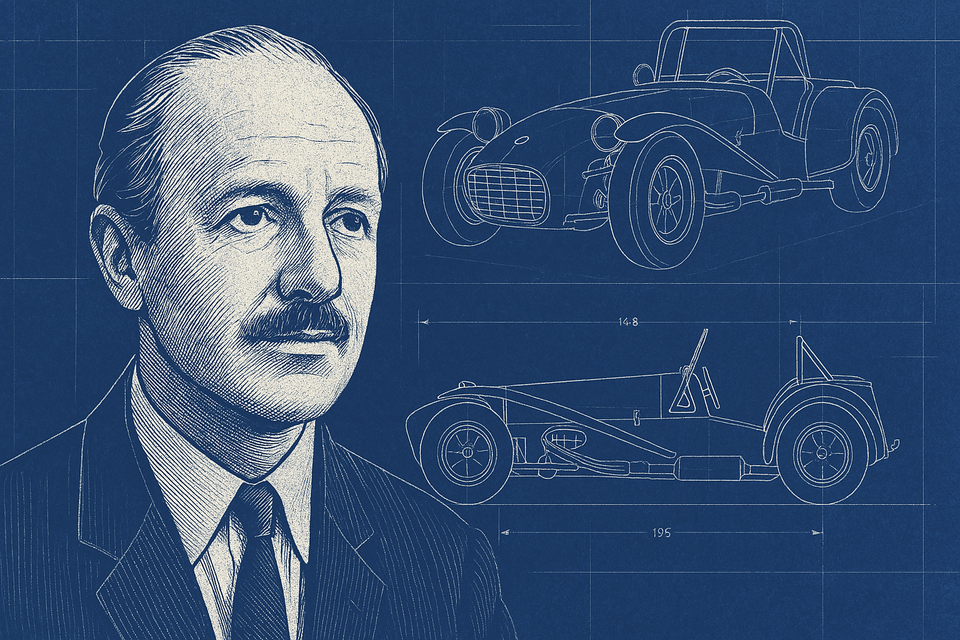The Chapman Principle : Remove Until It Works

Some designs succeed by adding power. Others succeed by removing everything that obstructs the goal.
Colin Chapman, founder of Lotus Cars and a pioneering Formula One engineer, shaped an entire generation of vehicle design with a deceptively simple mantra: “Simplify, then add lightness.” For Chapman, performance did not come from excess. It emerged from discipline. From stripping away, not layering on.
His approach offers one of the clearest, sharpest models of engineering leadership. And it could not be more relevant to modern IT.
Origins: Weight Was the Enemy
At Lotus, engineering was not a department. It was the foundation. The company began as an engineering centre of gravity, designing components for other manufacturers, tuning engines, and solving mechanical problems before building its own cars. The vehicles were not the starting point. They were proof of engineering mastery.
This foundation shaped everything that followed. Chapman’s cars expressed what the engineering team had already tested, simplified, and earned through experience.
Chapman began as an aeronautical engineer and applied those principles to automotive design. He believed excess weight masked design flaws and diluted driver control. From suspension to chassis, Lotus innovations focused on reducing complexity while increasing responsiveness.
He did not introduce minimalism for stylebut for engineering clarity. Lighter cars brake faster, accelerate sooner, and corner harder. Every gram saved became an advantage.
What Technical Leaders Can Learn
Structure teams for agility and learning. Like the Lotus factory's T-shaped model, engineering organisations thrive when individuals combine depth in one area with exposure across others. Team rotation, shared standards, and mutual accountability increase resilience and reduce bottlenecks.
Remove until it works. Then stop. Adding features, abstractions, or scale too early weakens clarity. Start lean. Solve precisely. Then refine.
Performance is often a consequence of subtraction. A lighter, simpler system runs faster and fails less. Complexity introduces drag.
Understand the platform before optimising it. Chapman’s cars were not powerful. They were purposeful. Understand your architecture, then shape performance around its strengths.
Simplification is an active discipline. It takes courage to cut code, remove tools, or decline edge cases. But that is where clarity emerges.
Build for feel, not just function. Lotus drivers described a sense of control and connection. In IT, this maps to intuitive tooling, clear APIs, and feedback-rich systems.
Case Study: The Lotus Elise — Engineering as Expression
Simplicity also creates joy. The absence of interference makes room for presence. Every shift, input, and response becomes more rewarding.
Contrary to popular belief, Lotus cars, while often associated with minimalism, are not fragile. Many owners, myself included, have driven them for hundreds of thousands of miles. They are reliable, mechanically honest, and continue to hold or even increase their value over time. This longevity is not accidental. It reflects engineering intent: design systems that perform so well that they remain relevant, durable, and trusted.
A loyal community surrounds Lotus ownership, not because the cars promise luxury, but because, again, they deliver clarity. What you feel through the wheel, you trust. What you see under the bodywork, you understand.
The Lotus Elise, introduced in 1996, became the embodiment of Chapman’s philosophy for a new generation. Lotus Engineering did not design it to offer luxury. They did not optimise it for broad appeal. It was engineered as a statement: lightness, mechanical honesty, and raw driving connection still matter.
The Elise featured an aluminium bonded chassis, exposed gear linkages, and almost no unnecessary trim. Engineers focused on mass reduction at every level. From structure to seating. The result was not just a light car, but one that delivered a uniquely tactile driving experience.
In IT terms, this mirrors the design of a lean, transparent internal platform: no noise, no indulgence, just sharp tooling and high feedback. The Elise proved that disciplined constraint could still excite, delight, and outperform heavier, more bloated competitors.
The Factory: Engineering Culture in Motion
The Lotus factory reflects the same philosophy found in the cars: lean, precise, and deeply human. It operates on the T-shaped model—where every employee develops depth in one skill while gaining breadth across many. Team members rotate between stations, learn through practice, and stay connected to the product as a whole.
This approach breeds agility and ownership. It allows the factory to operate efficiently, even on a four-day workweek, without compromising output or quality. It does not involve cutting corners—it involves sharpening every edge.
In IT, this maps directly to high-performing teams: cross-functional, adaptable, and empowered to improve the system from within. Simplicity becomes scalable when the people who build it understand it deeply.
Platform Thinking at Lotus: Modularity Without Compromise
One of the most remarkable aspects of Lotus engineering is its use of a shared, lightweight chassis platform. Particularly the aluminium bonded structure featured in the Elise, Exige, and Evora. This modular approach enabled the company to meet diverse customer needs without multiplying complexity. The platform served as a core asset: strong, light, and adaptable.
This is more than clever reuse. It is strategic flexibility. Lotus could build high-performance track cars, comfortable road models, and even limited-run variants on the same underlying structure. In some cases, customers and specialist tuners built on this base, extending functionality much like developers build on cloud platforms or internal tools.
In IT, this reflects the strength of well-defined, extensible platforms. A cloud provider may only see part of its stack integrated into a client's solution. And by exposing key interfaces, the provider enables others to deliver final value. Modularity, when executed with purpose, amplifies user success.
A Culture of Testing and Trust
Lotus did not rely on theory alone. The company invested heavily in real-world validation : testing, learning, and refining. So committed were they to performance through proof that they acquired their own test track to evaluate both prototypes and production models under realistic conditions. This facility, Lotus' test track at Hethel, became the heartbeat of its engineering process.
This mindset shaped every product: Lotus released nothing until it had been exercised, challenged, and understood. The track became a proving ground not just for performance, but for reliability.
Let IT leaders hear that clear message. Test in real environments. Simulate stress. Build feedback into the development loop. Do not release what has not been genuinely observed in action.
Behind the Design: No Safety Blanket
Chapman did not simply cut. He also dared. He embraced bold experimentation when it served the goal. From ground effect aerodynamics to composite monocoques, his innovations reshaped racing and redefined what engineering could achieve when freed from legacy assumptions.
Lotus does not build cars for comfort. They do not overbuild. Yet the cars won. Because they did what mattered and nothing else. They did not hide behind size or power. They exposed the problem, and then solved it.
This philosophy applies in every high-stakes delivery environment. Do not hide complexity behind layers. Remove, reveal, and resolve.
True simplicity does not remove capability. It removes confusion.
Legacy Beyond the Track
Great systems inspire the next generation. Chapman’s legacy outlived him not because of brand or trend, but because his principles kept delivering. In engineering, as in IT, clarity scales. Discipline multiplies. Philosophy lives on.
Final Takeaway: Cut with Intent, Deliver with Discipline
Chapman’s genius lay in subtraction. He questioned every part, every ounce, every assumption. He built machines that delivered more by carrying less.
IT leaders can adopt the same stance: clarify before scaling, prove before releasing, and measure impact not by volume but by trust.
Remove until it works. Then stop.
Simplicity does not reflect a lack of ambition. It reflects the highest form of engineering clarity.





Member discussion